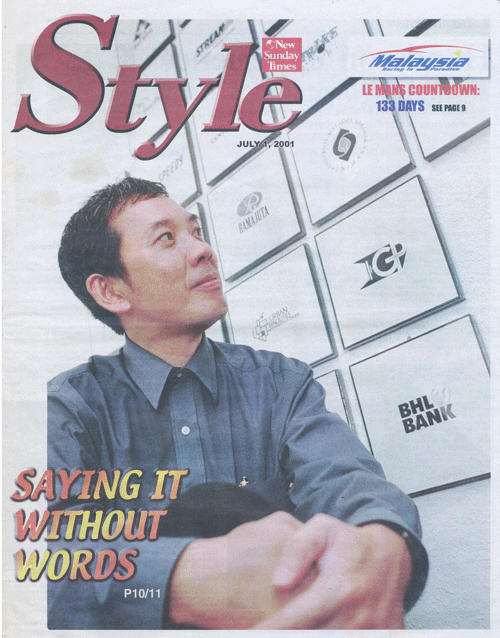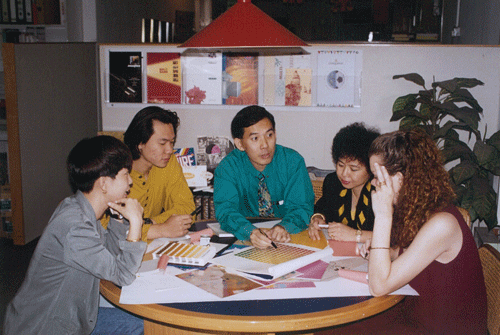
GRAPHIC designer Koh Lee Meng solves client’s problems by design. His graphic design firm, Koh Design Consultants, set up in 1984, is his vehicle for creative expression.
As a graphic design firm, Koh Design Consultants creates corporate identity programmes and designs packaging, environmental graphics (includes signage), promotional material, annual reports and other corporate literature. The firm’s tagline is aptly: “We communicate by design”.
Graphic designers are visual communicators. (The term “graphic designer” was coined by American book and type designer William Addison Dwiggins in 1922 and achieved widespread usage only after World War II. Prior to that, they were known as commercial artists.) As visual communicators, graphic designers use graphic design alone as a medium of communication, unlike advertising agencies.
Advertising agencies, on the other hand, use anything and everything appropriate to their business: video, the written word, multimedia, photography, illustration, animation and graphic design as well.
Graphic designers do use copy on the occasion, sparingly. If copy is used, the words are well-chosen and few and integrated into the design. Graphic designers play with fonts, colour, layout and pictures.
Another difference is that advertising agencies earn commissions through media placing whereas graphic design firms earn their bread and butter through designing alone.
Moreover, advertising agencies are usually more segmented, employ more people and offer more services.
Koh is happy to be a graphic designer. “I can indulge in all types of projects, from central vacuum systems to apparel. It’s very interesting as you get to learn different things. This opens up a lot of job opportunities for graphic designers.”
Koh, who is in his early 40s, believes that “Money is secondary. Firstly, you need to be sincere. You need to solve the (client’s) problem first. If incidentally, you make money, why not?”
He is of the opinion that it is okay for one to make money, that a graphic designer need not be destitute, and that graphic design should be a professional practice. Koh thinks graphic design colleges should include the professional practice of design as a subject in its course.
He finds that skills like drafting business letters and an understanding of design administration are sorely lacking in graphic design graduates today.
Koh says: “What I learned over 17 years could have been condensed into one to two years in the college.”
To Koh’s credit, his design firm has survived two economic recessions and is still going strong. When he set up his own firm in 1984, it was immediately hit by the start of the mid-80 recession. The lessons learned then? To conserve.
He cut down on the cost of paper by recycling - the back of the paper page would be used for work too.
Instead of using Artliners, which then cost RM1.60 each, he turned to using ballpoint pens, which then cost 20 sen each. And the air-conditioning in the office was switched off for lunch hour between 1 and 2pm and after 5pm if a room was not being used. Through these means, Koh managed to cut cost by about 20 to 30 per cent in those hard times.
But more than cutting cost, it is Koh’s “determination and aspiration” (as he sees it) and the ability to stay positive that has helped his firm survive. The intertwining of graphic design as both a hobby and a vocation to him helped, he adds.
The situation got so bad that Koh recalls not being able to pay wages and not having enough money to put petrol in the car.
“We were living on roti canai,” Koh confides. But having chosen his path, Koh felt he could not retrace his steps, but had to press on. Anyway, he figured that as he was young, he could hack it, and besides, he reckoned hardship is a passing thing.
Travel writer and tourism consultant Andrew Ponnampalam, an associate of Koh for over two decades, describes Koh in his early years as “incredibly focused, untiringly enthusiastic and indefatigably hardworking”.
“The man was simply bursting with energy! I think the quality that set him apart from his creative peers was his unwavering focus and dogged determination. Graphic design was what he believed every developed nation needed. If Malaysia wasn’t ready for it, he would wait... When it was, he’d be there.”
When Koh moved his office - for the second time - to the present premises in 1996, he soon ran smack into the second recession.
However, the 1997 recession did not affect Koh Design Consultants the way the first recession did because the firm had ‘good’ clients this time round. During the earlier recession, Koh’s firm was running up bad debts because of its furniture and construction clients, who were badly hit by the recession.
Koh’s first venture into the working world was in 1980 in an advertising agency. Between 1980 and 1984, Koh worked in two different agencies, rising through the ranks from a visualiser to studio manager and finally, to art director, which is his childhood dream.
When Koh struck out on his own in 1984 in a little room at the back of a shophouse, about 50 per cent of his work came from public relations firms. Now, most of his clients are direct clients.
“When I was small, I dreamt I would become an art director. My art teacher in secondary school, who was also the prefect master, was instrumental in my becoming a graphic designer. I did well in art lessons in school.
“In primary school, I helped paint a wall mural. And in secondary school, I started the art club and became its president. I also became a prefect because of my art teacher’s recommendation.
“Before the Form Five results came out, I had already enrolled in a graphic design course. I went to a local art school, Kuala Lumpur College of Art, and did fine arts there, which included oil painting. I finished the three-year course in two-and-half and immediately went to the United Kingdom to do a three-year diploma in graphic design at Colchester School of Art in Essex. I knew what I wanted in life - graphic design as my vocation. It was also my hobby.”
Koh says a graphic designer needs to be well-versed in related subjects in order to be able to “see out of the box”. A good grasp of general knowledge and wide exposure are helpful.
The current emphasis on IT and computers does not necessarily nurture a good graphic designer, Koh says. “Creative thinking is lacking today.” He thinks it a pity that the appreciation of fine arts as a subject is left out of the curriculum of most graphic design colleges here.
Koh Design Consultant’s current office in Section 14, Petaling Jaya, is a veritable visual treat; it has been designed to be conducive to creativity. The entire office, from the reception area and indoor courtyard to the conference room, library, employees’ partitioned office space and Koh’s room are artistically done up. The indoor courtyard is especially appealing to the senses, with a spiral staircase leading up to the first floor.
Koh explains a graphic designer’s scope of work. “It covers design conceptualising, supervising, colour separation and overseeing printing. He needs to understand photography, printing, papers and typography as well. Design is only 20 to 30 per cent of the work. The other 70 per cent is related to the production process beyond design, such as colour separation, printing and knowledge of papers.”
In the initial stages, a graphic designer has to liaise with clients to understand what they want, then give the design direction, based on clients’ marketing requirements, to the design team so that they can come up with the design. A graphic designer may work with copywriters if copy is needed.
A turning stone in the firm’s history was in the late 1980s when Inter-Pacific Communications (part of Berjaya Group) appointed the firm as its design consultant. Koh worked with the group for about six months. At about the same time, Koh’s firm was also design consultant to a few PR companies, which was also a significant achievement.
In 1999, Koh and William Harald Wong, a well-known peer, went to various parts of India to give a five-day design talk on the theme: Great Design Journeys.
Other notable achievements by Koh Design Consultants include having their design works appear in a number of international publications, such as 100 Years World Trademarks, International Corporate Design Vol 1 (nine entries by Koh Design Consultants were featured) and Vol 2 (five entries), and Trademarks and Symbols of the World (nine entries). A remarkable achievement given Koh Design Consultants’ designs were the only ones picked from Malaysia to appear in these books.
As a college student in UK, Koh won the award for Overall Best Student in Graphic Design for the academic year 1978/79. As a firm, Koh Design Consultants also won prestigious awards. The firm was a finalist in the Conqueror Design Competition for two years, 1986 and 1987, under the Corporate Identity Design category.
In 1989, under the Malaysian Corporate Report Awards organised by the Malaysian Institute of Management, it won the Silver Award and the Graphic Presentation Commendation Award - for designing the Inter-Pacific Annual Report. In 1995, the firm was nominated for the Horseman Award for Design under the Corporate Identity Design category.
Koh is modest about his achievements. He says: “So far, I’ve been very lucky. No matter how hard-working, if you have no luck, you cannot make it.”
He puts it down as 30 per cent hard work, 30 per cent luck, and 40 per cent the right professional relationships, positive thinking and business acumen.
Koh prefers business growth to be “slow and steady” as he thinks the business will be better able to weather economic storms this way. Not only is money secondary to Koh, but he believes in ploughing back into society what he’s gained. He fulfils his social obligations – of contributing back to society - by being a Rotarian.
I ask if he feels he has arrived, that he has achieved his lifelong dreams and ambition. “I’m comfortable now. We’re prudent, not extravagant, although if necessary, we do splurge once in a while. Good housekeeping is necessary,” Koh replies.
Koh goes on to express his business philosophy: “You need to be very honest in your dealings. Otherwise clients will not come back. You must give clients their money’s worth.”
K
oh is one of the founding members of Graphic Design Association of Malaysia (wREGA: Pertubuhan Wakaf Reka Grafik Malaysia).
Koh sees his current role in wREGA as providing him with the opportunity to serve society and specifically, the graphic design community.
Through wREGA, Koh feels he has an effective and spot-on channel to impart knowledge to budding, up-and-coming graphic designers.
Knowledge gained through 17 years of practical experience in the industry would be wasted if not shared.

